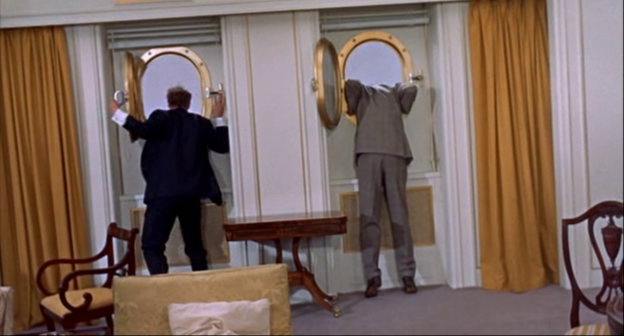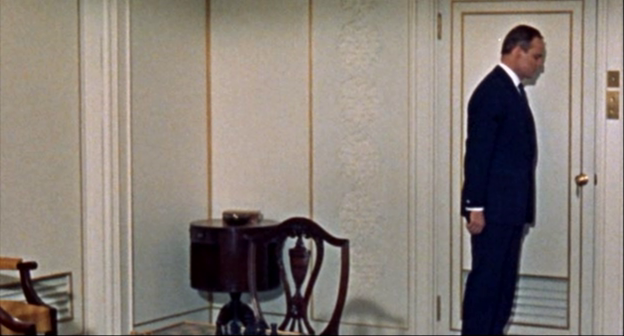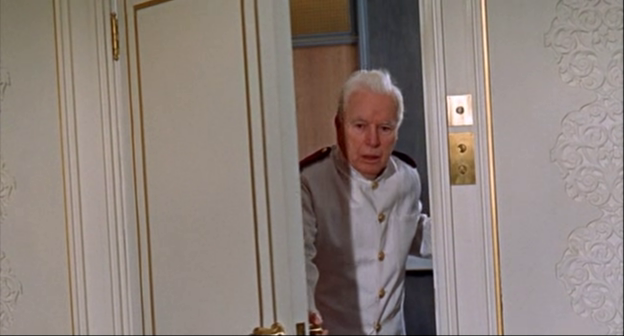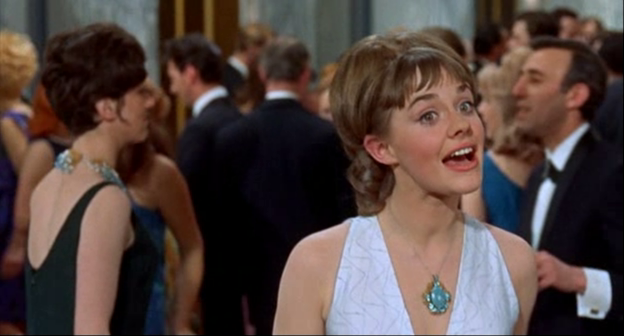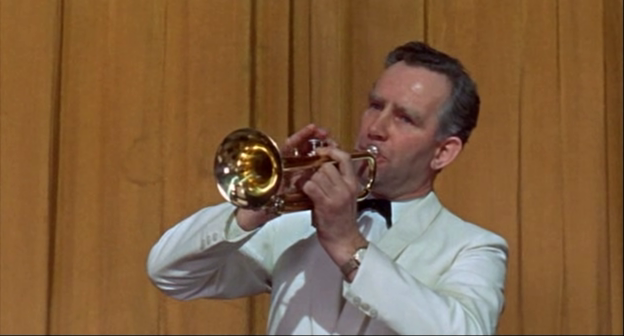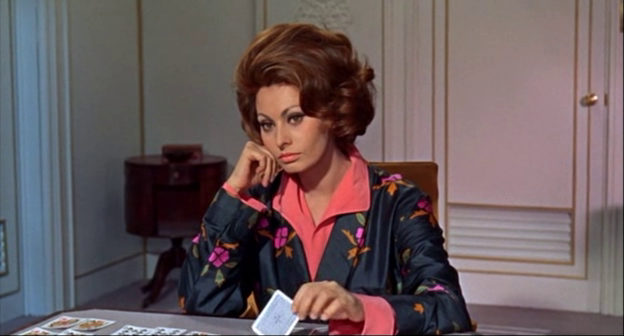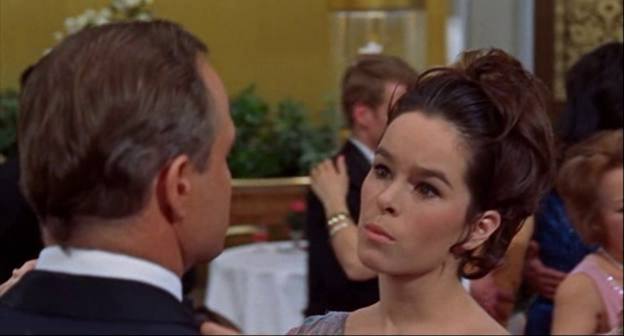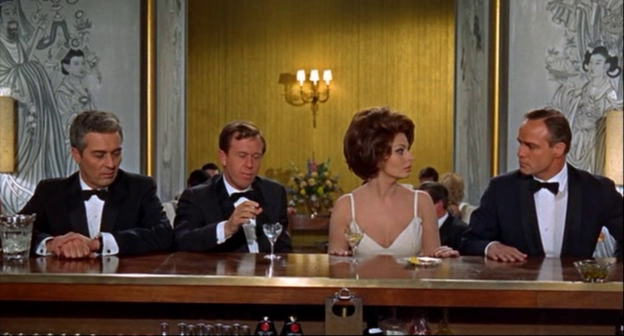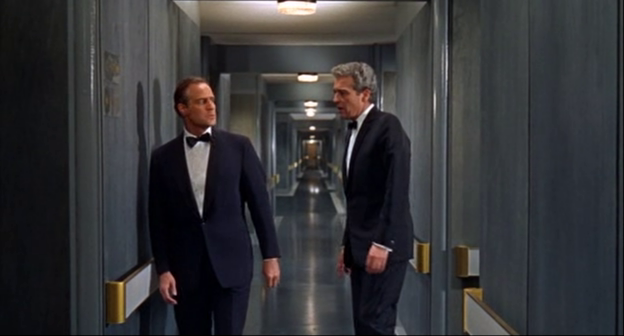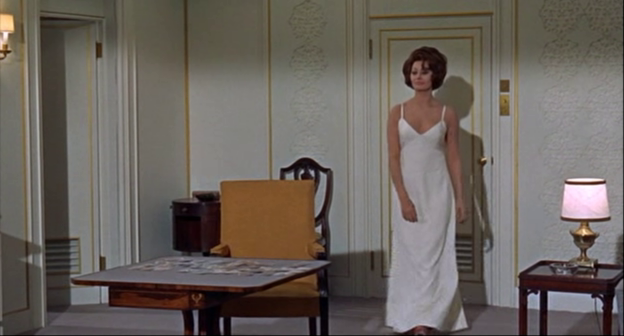
Tippi Hedren in A COUNTESS FROM HONG KONG, not helped by the material, still has the quality that baffled critics in her two films for Hitchcock — it can be quite hard to tell if she’s a good actor. She is — her good moments prove it. But one doesn’t always feel confident of it. Maybe it’s the kind of acting — or kinds, rather — that throws me. She can do intensely real moments of strong emotion, quite unexpectedly. During quieter scenes she still has the air of the fashion model she once was — there’s a slight sense of assumed poise… and self-consciousness? this may be most effective, and least visible, in MARNIE, where she really is either constantly assuming a role or else experiencing strong emotion.
Anyhow, I like her, and I’m glad Hitch finally let her go to do this. Ageing London-born filmmakers should support one another.
Tippi’s first scene is mostly about how Mrs Hudson — Sophia/Natascha, now married to Cargill/Hudson in the very definition of a farcical aquatic ceremony — is missing. Tipp gets a couple of comic lines which don’t really land because we’re wondering, I think, why she’s being so flippant about a missing woman.

Here’s Sophia! Hitching a ride to Waikiki. Odd how Honolulu so strongly resembles Pinewood.
Syd, Marlon and Captain John Paul ponder the mysterious disappearance of Mrs Hudson. It’s like the Marie Celeste all over again, but with just one woman. Syd gets to do some mime! Nudging Brando, he makes a motion with his hands to indicate “dove overboard.” There has been lots of physical acting in this film, but this is possibly the first bit of true pantomime.
Left all alone in Brando’s stateroom, Tippi hasn’t moved. Even the camera hasn’t moved. At least she has a newspaper.


Here’s a terrible story, and I don’t know where else I can mention it. The film was shown to the British press. Chaplin and his producer chum Jerry Epstein were present. And the projection was terrible: the image was poor, the film kept jumping and jamming. Viewing was interrupted every five minutes. The cinema said it was something to do with the anamorphic lens having been left on, and the projectionist currently on duty was not qualified to remove it. (This sounds dodgy.)
Epstein blamed the horrible viewing conditions for the bad reviews. Some reviewers, he claims, blamed the poor projection on the film being badly made, which is appallingly ignorant. I think the film is a dog-turkey crossbreed, though of scholarly interest and with a few laughs, and the reviews would probably have been poor anyway, but Epstein was right to be furious.
Here’s what they could have done: Chaplin could have gone out and addressed the critics: “I’m very sorry about this, but obviously we can’t expect you to assess the film under these circumstances. We’ll have to reschedule.” And he could have gone on a bit, spoken to the critics individually, charmed them. I think even the most cynical hack would have been fairly pleased at getting to chat with Chaplin. Would this be so corrupt? Maybe, but critics and filmmakers do talk occasionally. It would have been the closest to a win achievable in that non-ideal situation. The alternative, running the film so badly that even a Frenchman couldn’t enjoy it (France being the one country where I believe Chaplin’s last movie got some really good reviews), is pointless. Things wouldn’t have been appreciably worse if they’d cut off the film halfway and NEVER rescheduled it. If the critics weren’t able to see the film at all, they couldn’t review it, and usually no reviews are better than lousy ones.


Back to this lousy review. It’s emerging that Tippi’s lighthearted attitude is due to her suspecting that Hudson’s whole marriage story is fishy. I think something’s missing in showing the development of her suspicion. Meanwhile, we get an actual camera angle: a fancy-schmancy mirror shot. A nod to Hitchcock?
It don’t develop too good, though. When Tippi turns, Brando’s position ought to be cheated so we can see his face fully in the reflection, rather than having him blocked by a bun. This counts as carelessness by the operator, who should have suggested it, or by Chaplin, who may have rejected such a suggestion, impatient as he was with technical fiddle-faddle.
Tippi’s big scene with Marlon is another passionless affair, very much like Chaplin’s business with the Queen in A KING IN NEW YORK — “Neither one of us is to blame.” Tippi’s character announces that her only interest is money, since she has no children, a fairly awful thing to say, and I would think starting to look a little outdated to a fair number of 1967 potential audience members (I have to say “potential” as it turned out there wasn’t really an audience for this).
“I was going to say ‘love,'” says Tippi, “But I don’t think either one of us knows what the word means.” At this point in the story, fifteen minutes from the end, Marlon should really have some kind of small, significant reaction to this statement — doesn’t he feel the beginnings, even, of a glimmer for Sophia. But, without pausing, he changes the subject flatly: “Well, in any case…”

Sydney Chaplin gets a brief scene with a Hawaiian cabbie played by Cecil Cheng, who appeared two years later in THE BED SITTING ROOM as, oh dear, “Chinaman.” He gets a big laugh (from me, anyway) in that film, with one befuddled reaction shot near the end. It really looks like a confused bit-player who hasn’t been told what’s going to happen. Which is possible — Richard Lester, a man in a hurry. Cheng has a substantial career in this kind of role — a henchman in GOLDFINGER, a Military Technician (AKA henchman) in THE FIFTH ELEMENT…
The lobby of the Waikiki Hotel is a nice big set — so big you’re surprised to see it in this strangely claustrophobic film. But the ballroom on the ship was big too. The main expense is the sound stage, the actual wood to build these very large flats wouldn’t be prohibitive, and then the furnishings, including the big faux-Gauguin, probably come from Pinewood’s art department. Or else some talented scenic artist knocked it up in a week.


Why does the film nevertheless feel so cramped? The next scene expresses it better than I could. Waikiki Beach is pure process shot, and the background plates look decidedly English Channel rather than Pacific Ocean. It’s also depopulated: the Marie Celeste transformed from ship to shore.
Syd sometimes seems to have more interaction with Sophia than Marlon does — and seems more genuinely fond of her.
Syd has bought Sophia new clothes. The wardrobe supplied by Marlon was too big — Chaplinesque baggy pants. These ones are too small — Chaplinesque tight waistcoat. Sophia and the costume department get a laugh by popping the top buttons off with a single inhalation.


Josephine and Victoria Chaplin enter, with an unnamed friend, and get a token line apiece. Vicky would have been the star of the tantalizing-sounding THE FREAK, Chaplin’s proposed next film, as a winged woman. Imagine Angela Carter’s Nights at the Circus transposed through Chaplin’s Victorian mind. I imagine the flying effects would have been terrible, greatly inferior to those in Albert Lamorisse’s FIFI LA PLUME (which are remarkable, and wholly practical, but somehow still not quite convincing).
Still, there is no good reason other than paternal pride for this appearance. Tippi attempts to justify the wastage of film stock by sliding into frame immediately after them.



I wonder who was responsible for the decision to centre all the actors in frame for their closeups? I’m very used to people being offset to one side or the other, so this style of composition feels terribly awkward. Acceptable in the 1:1.33 aspect ratio, but too spacious here, and somehow makes everybody seem divorced from their environment, adrift in a world that’s trying to look like a process shot even when it isn’t one. I’m sure the pan-and-scan technician was very happy, though.
Ten minutes to go! I should really aim to get this one in the bag before leaving for Bologna on Monday morning…
TO BE CONCLUDED?
